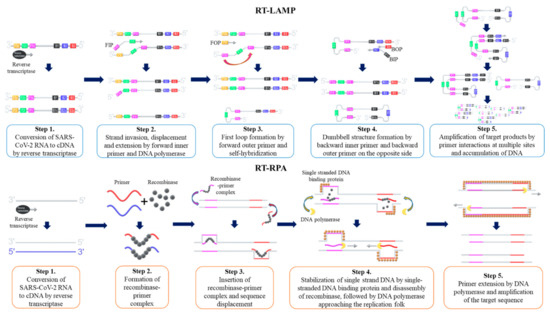1000/1000
Hot
Most Recent

The coronavirus disease 2019 (COVID-19) has caused a large global outbreak. It is accordingly important to develop accurate and rapid diagnostic methods. The polymerase chain reaction (PCR)-based method including reverse transcription-polymerase chain reaction (RT-PCR) is the most widely used assay for the detection of SARS-CoV-2 RNA. Along with the RT-PCR method, digital PCR has emerged as a powerful tool to quantify nucleic acid of the virus with high accuracy and sensitivity. Non-PCR based techniques such as reverse transcription loop-mediated isothermal amplification (RT-LAMP) and reverse transcription recombinase polymerase amplification (RT-RPA) are considered to be rapid and simple nucleic acid detection methods and were reviewed in this entry. Non-conventional molecular diagnostic methods including next-generation sequencing (NGS), CRISPR-based assays and nanotechnology are improving the accuracy and sensitivity of COVID-19 diagnosis.
| GISAID Clades | PANGO Lineage | Nextstrain Clades | Notable Variants |
|---|---|---|---|
| S | A | 19B | A.23.1 |
| L | B | 19A | Wuhan-Hu-1 |
| V | |||
| G | B.1 | 20A | B.1.525, B.1.627 |
| GH | B.1 | 20C | B.1.427, B.1.429, B.1.526 |
| B.1.2 | 20G | ||
| B.1.596 | |||
| B.1.351 | 20H/501.Y.V2 | B.1.351 | |
| GR | B.1.1.1 | 20B | |
| P.3 | P.3 | ||
| C | 20D | ||
| D.2 | 20F | ||
| P.1 | 20J/501.Y.V3 | P.1 | |
| GV | B.1.177 | 20E (EU1) | B.1.177 |
| GRY | B.1.1.7 | 20I/501.Y.V1 | B.1.1.7 |
| PANGO Lineage | CDC Designation | PHE Designation | First Detected | Spike Protein Substitutions |
|---|---|---|---|---|
| B.1.1.7 | VOC | VOC-20DEC-01, VOC-21FEB-02 * | United Kingdom | 69del, 70del, 144del, (E484K), (S494P), N501Y, A570D, D614G, P681H, T716I, S982A, D1118H (K1191N) |
| B.1.351 | VOC | VOC-20DEC-02 | South Africa | D80A, D215G, 241del, 242del, 243del, K417N, E484K, N501Y, D614G, A701V |
| P.2 | VOI | VUI-21JAN-01 | Brazil | E484K, (F565L), D614G, V1176F |
| P.1 | VOC | VOC-21JAN-02 | Brazil | L18F, T20N, P26S, D138Y, R190S, K417T, E484K, N501Y, D614G, H655Y, T1027I |
| A.23.1 | - | VUI-21FEB-01 * | Uganda | F157L, V367F, (E484K), Q613H, P681R |
| B.1.525 | VOI | VUI-21FEB-03 | United Kingdom | A67V, 69del, 70del, 144del, E484K, D614G, Q677H, F888L |
| B.1.1.318 | - | VUI-21FEB-04 | United Kingdom | D614G, D796H, E484K, P681H, T95I, 144del |
| P.3 | - | VUI-21MAR-02 | Philippines | E484K, N501Y, P681H |
| B.1.617 | VOI | VUI-21APR-01 | India | L452R, E484Q, D614G |
| B.1.617.2 | VOI | VOC-21APR-02 | India | T19R, (G142D), 156del, 157del, R158G, L452R, T478K, D614G, P681R, D950N |
| B.1.617.3 | VOI | VUI-21APR-03 | India | T19R, G142D, L452R, E484Q, D614G, P681R, D950N |
| AV.1 | - | VUI-21MAY-01 | United Kingdom | D80G, T95I, G142D, 144del, N439K, E484K, D614G, P681H, I1130V, D1139H |
| B.1.617.1 | VOI | - | India | (T95I), G142D, E154K, L452R, E484Q, D614G, P681R, Q1071H |
| B.1.526 | VOI | - | United States | (L5F), T95I, D253G, (S477N), (E484K), D614G, (A701V) |
| B.1.526.1 | VOI | - | United States | D80G, 144del, F157S, L452R, D614G, (T791I), (T859N), D950H |
| B.1.427 | VOC | - | United States | L452R, D614G |
| B.1.429 | VOC | - | United States | S13I, W152C, L452R, D614G |


| Method | Components | Temperature | Time | Detection Method | Advantages * | Disadvantages * |
|---|---|---|---|---|---|---|
| Loop-mediated isothermal amplification (LAMP) | DNA polymerase, forward inner primer, backward inner primer, forward outer primer, backward outer primer | 60–65 °C | >1 h | Colorimetric, turbimetric, fluorescence probe, intercalating dye | High specificity. Less sensitive to inhibitors in biological samples | False positive in negative control |
| Recombinase polymerase amplification (RPA) | Recombinase, single stranded binding protein, DNA polymerase, forward primer, reverse primer | 37–42 °C | >1 h | Fluorescence, antigenic-tag (antibody) | Performed in the presence of PCR inhibitors. Fast and sensitive | Inhibited by detergents (SDS and CTAB). Non-specific/high background signal |
| Nucleic acid sequence-based amplification (NASBA) | RNase H, reverse transcriptase, T7 DNA-dependent RNA polymerase, forward primer with T7 promoter sequence, reverse primer | 41 °C | >2 h | Fluorescence | More sensitive and less time-consuming | Non-specific reactions/false positives |
| Strand-displacement amplification (SDA) | DNA polymerase, restriction endonuclease, primers, dCTP, dTTP, dGTP, dATPα | 37–49 °C | >2 h | Fluorescence | High specificity. Detection of large RNA molecules | Non-specific reaction/high background signal |
| Rolling circle amplification (RCA) | DNA ligase, DNA polymerase, primer, padlock probe | 30–37 °C | >1.5 h | Fluorescence | High specificity | False negatives and false positives |